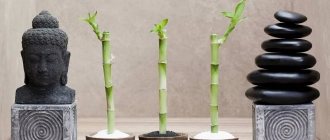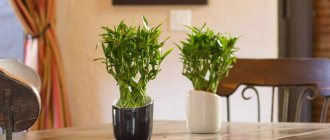- September 22, 2019
- Houseplants
- Maria Vetoshkina
Flower growers love to grow bamboo, because it is easy to care for and you can create a variety of unique compositions from it. At the same time, bamboo is planted differently, and each method has its own advantages. That is why information on how to replant bamboo at home will be of interest to many.
Transfer rules
Bamboo shoots are best germinated in water. They should be transplanted into the ground when the roots reach 4-5 cm. Bamboo cuttings with small roots do not take root well, and roots that are too long are easy to damage during planting. It is necessary to remove the cuttings from the water before planting.
You can use any rooting agent; you just need to sprinkle it on the damp roots. A pot of soil must be prepared in advance; a hole in the soil must be made slightly larger than the rhizome.
The soil should be added in small portions until the pot is filled. The soil should not be compacted too much to avoid damaging the young roots.
After planting, the cuttings are watered and, if necessary, soil is added. In order for the young shoot to take root better, it can be sprayed with water in the first week.
Fertilizer feeding
Whatever growing method you choose, bamboo needs to be fertilized regularly. For this, organic and mineral fertilizers are usually used. Specialized fertilizers for dracaena can be purchased at flower shops. Their advantage is that they contain a complete set of elements necessary for plants.
During the cold season, fertilizing is carried out several times a month. In summer, it is enough to apply fertilizer once every three weeks. If you notice that a houseplant is growing too slowly, then this is a reason to think about the need for fertilizing.
Experienced gardeners recommend giving preference to growing bamboo in the ground. The plant can survive in water for a year or more. Its lifespan depends on the quality of care. Sooner or later, the bamboo disappears in the water. Therefore, it is better to plant it in the ground so that the crop will please you with its decorative effect longer.
Selecting a site and preparing for transplantation
Before transplanting, you need to prepare everything you need. To do this you will need: a planting container, soil, drainage material, and a means for rooting the flower.
The choice of location also needs to be approached carefully. Bamboo came to us from tropical forests, where the climate is humid and warm. Therefore, a bamboo indoor plant will do well in a warm and well-lit corner. He only needs diffused light; light partial shade is also suitable. The most comfortable temperature is considered to be from 20 to 25 degrees. In the room where bamboo grows, the air should not stagnate.
General information
This is an original indoor decoration with a bare stem, at the top of which there are branches with leaves. The trunk can be either straight or curved. Due to this, you can create fancy compositions. Most often, the domestic variety has a green tint. But there are some species with golden foliage and stems.
Since propagating bamboo is not particularly difficult, it is enough to find the mother plant from someone you know. If you adhere to the philosophy of Feng Shui, then young bamboo should definitely appear in your home. It will not only bring prosperity, but also diversify your flower collection.
Soil and pot for the plant
In what soil should I plant bamboo? This plant belongs to the dracaena family, so for planting it, a ready-made soil mixture specially designed for dracaenas is best suited. It can be purchased at a specialty store.
The container for planting bamboo can be anything, the main thing is that it must meet two requirements:
- The diameter of the pot should be approximately twice the size of the plant's rhizome.
- The pot must have drainage holes.
The plant will look very impressive in a beautiful vase if its stems are additionally tied with a bright ribbon.
How to replant bamboo in an apartment
Bamboo is an unpretentious plant; it grows well in water, in soil, and in hydrogel. But he will feel best in the ground.
The process of planting bamboo in a pot is as follows:
- For planting, you need to choose healthy, richly green seedlings that have living, undamaged roots.
- It is better to choose a pot deep enough and spacious enough so that the roots have room to grow. Particular attention should be paid to the drainage holes to ensure the outflow of water from the container.
- The soil, as mentioned above, must be taken ready-made. Expanded clay or small pebbles are suitable for drainage.
- Water for irrigation should be melted or settled.
The drainage layer should be at least 3 cm; moistened soil is placed on it in small portions and a hole is immediately made. The cuttings are taken out of the water, a preparation for root growth should be sprinkled on the roots and a little of this preparation should be added to the hole itself.
The roots are sprinkled with earth, compacted a little, and the pot is completely filled with soil. Water thoroughly so that water flows out through the drainage holes. Water must be removed from the pan so that it does not stagnate.
Mr. Summer Resident informs: ways to grow bamboo at home
At home, the plant develops well in water. It is enough to change it once a week. Indoor varieties are unpretentious, they quickly gain weight and produce layering. It is allowed to add growth stimulants and fertilizers to the water (1/3 of the recommended amount so that there is no stress for the sprout). In indoor conditions or in a winter garden when grown in soil, bamboo stems reach a height of 2 meters. In a short time, flower growers create real tropical thickets. It is important to feed the crop in a timely manner and not let the water stagnate.
Plastic is not recommended for growing; it is better to choose glass or stainless steel containers of large volume; it is acceptable to use tall jugs. The vessels are placed near a window or light source. The plant gives good growth under a phytolamp. Water for bamboo shoots is first left to stand in an open container so that the chlorine evaporates.
Filtered or tap water is not suitable for the plant. The plant reacts very well to melt water.
Possible problems
The above describes in detail how to replant bamboo, but after replanting the following problems may arise:
- The tips of the leaves dry out. Dry air or lack of heat is to blame for this.
- The leaves begin to turn yellow. If the leaves turn yellow slowly and infrequently, then this can be considered a natural process. If the leaves turn yellow constantly, this indicates a lack of nutrition; the plant needs to be fed.
- The leaves are curling up. This may be due to low temperature.
- Spots appear on the leaves: yellow-brown or dry. They can be caused by direct sunlight.
Appearance
Bamboo is a bare stem with several shoots developing at the end.
Various compositions from this plant look very impressive.
The color of the stem varies from bright green to golden straw. It can twist into spirals of various shapes . Leaves are lanceolate. The intensity of leaf color depends on the lighting in the room. The rich green color of the foliage occurs only in bright light during the day. The indoor plant blooms very rarely. Flowers can form into panicles or appear singly on shoots.
Unlike the not-so-pretentious bamboo, propagating and growing indoor azaleas will require increased attention and patience from you. But this beautiful flower is worth the effort! Bright large flowers against the backdrop of lush green leaves will decorate any interior and cause genuine admiration.
If you prefer exquisite flowers, you should pay attention to the orchid. The phalaenopsis hybrid is most suitable for home breeding. Here is more information about the propagation and cultivation of this type of orchid.
Lighting, humidity and temperature
Proper lighting is important for any plant. Bamboo, like other dracaenas, loves bright rooms, but direct sunlight will not benefit the plant. Direct sun may cause burns on the leaves. The flower will feel good in diffused sunlight. It will grow in partial shade, but insufficient lighting inhibits growth, and in this case the leaves may turn pale.
Bamboo is a tropical plant, so dry air is unacceptable for it. To humidify the air around the plant, you can place containers of water nearby, or use a special humidifier. The flower will also appreciate daily spraying.
Homemade bamboo loves warmth very much. In an ordinary apartment he will be quite comfortable, you just need to make sure that the air temperature does not drop below 20 degrees. The room where the plant is located can, and even should, be ventilated, but bamboo does not like drafts.
Thus, if you follow the conditions of keeping the plant, then planting bamboo, as described above, will not be difficult, because the plant will be healthy and strong.
Features of care in winter
During the winter season, most of the plant goes into a dormant state. Bamboo was no exception - in cold weather, the plant does not grow new leaves, and shoot growth practically stops.
The gardener needs to monitor the air temperature - it should not fall below +18 degrees. Watering is reduced to once a week. If the daylight hours are too short, you should take care of additional artificial lighting.
Plant pests and diseases
A healthy flower is practically not affected by diseases and pests. The latter include spider mites and mealybugs.
The first entangles the leaves with a cobweb. Spraying with Aktara helps combat it.
Mealybug appears as white lumps in the leaf axils. These lumps need to be removed and then treated with the Actellik insecticide.
The following diseases can be noted:
- Dark spots on the leaves are a fungal disease. It is necessary to treat the plant with a fungicide and ventilate the room more often.
- Slow growth - the plant lacks minerals. You need to feed it with a complex product.
- The leaves become dark and soft - the temperature in the room is too low, it needs to be increased.
Stem formation
Stores often sell Dracaena Sander with spectacularly twisted trunks, sometimes forming an intricate geometric pattern. Experienced florists can achieve this effect under special conditions. But the dracaena stem is very flexible and elastic, which means that nothing and no one prevents the owner from trying to twist the bamboo trunk on his own.
You can do this in several ways:
- Place the stem in a plastic tube of the desired shape, which is removed after a few weeks.
- Form the desired bend using wire.
- Place the plant in an opaque box with folding walls that can be opened one at a time. The plant will begin to reach for the light and bend in the right direction.
It should be understood that after the formation of the trunk, the dracaena will continue to grow in the vertical direction.











